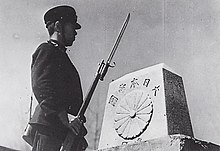Type 30 bayonet
| Type 30 bayonet | |
|---|---|
 Japanese Type 30 Bayonet | |
| Type | Bayonet |
| Service history | |
| Used by | |
| Wars | Russo-Japanese War World War I Second Sino-Japanese War World War II |
| Production history | |
| Designed | 1897 |
| Produced | 1897-1945 |
| No. built | ~8,400,000 |
| Specifications | |
| Mass | 700 grams |
| Length | 514 millimetres (20.24 in) |
| Blade length | 400 millimetres (15.75 in) |
The Type 30 bayonet (三十年式銃剣, sanjūnen-shiki jūken) was a bayonet designed for the Imperial Japanese Army to be used with the Arisaka Type 30 Rifle and was later used on the Type 38 and Type 99 rifles. Some 8.4 million were produced, and it remained in front-line use from the Russo-Japanese War to the end of World War II.
Description

The Type 30 Bayonet was a single-edged sword bayonet with a 400 millimetres (15.75 in) blade and an overall length of 514 millimetres (20.24 in) with a weight of approximately 700 grams. The Type 30 bayonet is also known as the “Pattern 1897 bayonet”. Early Type 30 bayonets usually sported a hooked quillion guard which gave it a distinct look, but later models had a straight hand guard.
The design was intended to give the average Japanese infantryman a long enough reach to pierce the abdomen of a cavalryman. However, the design had a number of drawbacks, some caused by the poor quality of forgings used, which tended to rust quickly and not hold an edge, and to break when bent.
The weapon was manufactured from 1897 to 1945 at a number of locations, including the Kokura Arsenal, Koishikawa Arsenal (Tokyo) and Nagoya Arsenal, as well as under contract by private manufacturers including Matsushita, Toyoda Automatic Loom and others.
